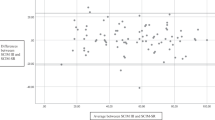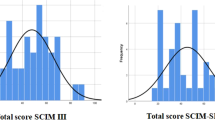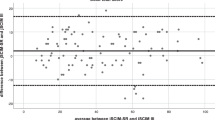Abstract
Study design
A methodological study.
Objectives
To establish the criterion-related validity of the Nepali version of the Spinal Cord Independence Measure Self-Report (SCIM-SR).
Setting
Outpatient Department of the Spinal Injury Rehabilitation Center and community of Province no. 3, Nepal.
Methods
Community-dwelling individuals with spinal cord injury were enrolled. Participants self-administered the Nepali version of the SCIM-SR while a clinician concurrently administered the SCIM III. Descriptive statistics characterized the sample, while Spearman’s rank correlation coefficient and Intraclass correlation coefficient assessed the association between the SCIM III and the Nepali version of the SCIM-SR. Bland Altman’s analysis determined the differences.
Results
The Spearman’s rank correlation coefficient for the total score was 0.961, self-care subscale was 0.590, respiration and sphincter management subscale was 0.897, and mobility subscale was 0.891. The ICC (2,1) and confidence interval for the total score, self-care subscale, respiration and sphincter management subscale, and mobility subscale were 0.989 (0.983–0.993), 0.873 (0.804–0.918), 0.955 (0.931–0.971) and 0.991 (0.987–0.994), respectively. The SCIM-SR scores were lower than the SCIM III in total and all subscale scores. The Bland-Altman’s difference for the total score, self-care subscale, respiration and sphincter management subscale, and mobility subscale were 2.55, 1.34, 0.83, and 0.38, respectively.
Conclusions
The Nepali version of the SCIM-SR was validated and can be used to evaluate the functional status of individuals with spinal cord injury in the community setting of Nepal.
This is a preview of subscription content, access via your institution
Access options
Subscribe to this journal
Receive 1 print issues and online access
We are sorry, but there is no personal subscription option available for your country.
Buy this article
- Purchase on SpringerLink
- Instant access to full article PDF
Prices may be subject to local taxes which are calculated during checkout



Similar content being viewed by others
Data availability
The datasets generated and/or analyzed during the current study are available from the corresponding author upon reasonable request.
References
Bot SDM, Terwee CB, van der Windt DAWM, Bouter LM, Dekker JM, de Vet HCW Psychometric evaluation of self-report questionnaires: the development of a checklist. In Adér HJ, Mellenberg C, editors, Proceedings of the second workshop on research methodology. Amsterdam: VU University. 2003. p. 161-8.
Cook C. Mode of administration bias. 2010;18:61-3. https://doi.org/10.1179/106698110X12640740712617.
Yorkston K, Baylor C. Patient-reported outcomes measures: an introduction for clinicians. Perspectives of the ASHA Special Interest Groups. 2019;4:8–15. https://doi.org/10.1044/2018_PERS-ST-2018-0001.
Demetriou C, Ozer BU, Essau CA. Self‐report questionnaires. Encyclopedia Clin Psychol. 2014:1-6. https://doi.org/10.1002/9781118625392.wbecp507.
Kc S, Sharma S, Ginn K, Almadi T, Reed D. Nepali translation, cross-cultural adaptation and measurement properties of the Shoulder Pain and Disability Index (SPADI). J Orthop Surg Res. 2019;14:284 .https://doi.org/10.1186/s13018-019-1285-8.
Mulcahey MJ, Calhoun CL, Sinko R, Kelly EH, Vogel LC. The spinal cord independence measure (SCIM)-III self report for youth. Spinal Cord. 2016;54:204–12. https://doi.org/10.1038/sc.2015.103.
Catz A, Itzkovich M, Tesio L, Biering-Sorensen F, Weeks C, Laramee MT, et al. A multicenter international study on the Spinal Cord Independence Measure, version III: Rasch psychometric validation. Spinal Cord. 2007;45:275–91. https://doi.org/10.1038/sj.sc.3101960.
Fekete C, Eriks-Hoogland I, Baumberger M, Catz A, Itzkovich M, Lüthi H, et al. Development and validation of a self-report version of the Spinal Cord Independence Measure (SCIM III). Spinal Cord. 2013;51:40–7. https://doi.org/10.1038/sc.2012.87.
Aguilar-Rodríguez M, Peña-Pachés L, Grao-Castellote C, Torralba-Collados F, Hervás-Marín D, Giner-Pascual M. Adaptation and validation of the Spanish self-report version of the Spinal Cord Independence Measure (SCIM III). Spinal Cord. 2015;53:451–4. https://doi.org/10.1038/sc.2014.225.
Bonavita J, Torre M, China S, Bressi F, Bonatti E, Capirossi R, et al. Validation of the Italian version of the Spinal Cord Independence Measure (SCIM III) Self-Report. Spinal Cord. 2016;54:553–60. https://doi.org/10.1038/sc.2015.187.
Jörgensen S, Butler Forslund E, Lundström U, Nilsson E, Levi R, Berndtsson E, et al. Sound psychometric properties of the Swedish version of the Spinal Cord Independence Measure Self-Report. J Rehabil Med. 2021;53:jrm00197. https://doi.org/10.2340/16501977-2839.
Khatri P, Prasertsukdee S, Suttiwong J. Reliability of the Nepali version of the spinal cord independence measure self-report. Rehabil Res Pract. 2022;2022:9983464 https://doi.org/10.1155/2022/9983464.
Takeuchi S, Uemura O, Unai K, Liu M. Adaptation and validation of the Japanese version of the Spinal Cord Independence Measure (SCIM III) self-report. Spinal Cord. 2021;59:1096–103. https://doi.org/10.1038/s41393-021-00633-5.
Wang T, Tang J, Xie S, He X, Wang Y, Liu T, et al. Translation and validation of the Chinese version of the Spinal Cord Independence Measure (SCIM III) Self-Report. Spinal Cord. 2021;59:1045–52. https://doi.org/10.1038/s41393-020-00601-5.
Wilartratsami S, Luksanapruksa P, Santipas B, Thanasomboonpan N, Kulprasutdilok P, Chavasiri S, et al. Cross-cultural adaptation and psychometric testing of the Thai version of the Spinal Cord Independence Measure III-Self Report. Spinal Cord. 2021;59:291–7. https://doi.org/10.1038/s41393-020-00556-7.
World Health Organization. ICF beginner’s guide: towards a common language for functioning, disability and health. 2002.
Acknowledgements
The author would like to thank Spinal Injury Rehabilitation Center, Nepal.
Author information
Authors and Affiliations
Contributions
Prakriti Khatri was responsible for designing the study, data analysis and interpretation, and drafting and revising the manuscript. Anjita Khadka contributed to the data collection and writing of the manuscript. Jatuporn Suttiwong contributed to the study design, data analysis and interpretation, and manuscript writing.
Corresponding author
Ethics declarations
Competing interests
The authors declare no competing interest.
Ethics approval
The study was approved by the Nepal Health Research Council. We certify that all applicable institutional and government regulations concerning the ethical use of human volunteers were followed during this research.
Additional information
Publisher’s note Springer Nature remains neutral with regard to jurisdictional claims in published maps and institutional affiliations.
Supplementary information
Rights and permissions
Springer Nature or its licensor (e.g. a society or other partner) holds exclusive rights to this article under a publishing agreement with the author(s) or other rightsholder(s); author self-archiving of the accepted manuscript version of this article is solely governed by the terms of such publishing agreement and applicable law.
About this article
Cite this article
Khatri, P., Khadka, A. & Suttiwong, J. Validation of the Nepali version of the Spinal Cord Independence Measure Self-Report. Spinal Cord Ser Cases 10, 76 (2024). https://doi.org/10.1038/s41394-024-00687-6
Received:
Revised:
Accepted:
Published:
DOI: https://doi.org/10.1038/s41394-024-00687-6



